A COVID-19 Reset for Climate Change: The Future We Choose: Surviving the Climate Crisis
- Lyla Hinkle
- Jun 17, 2020
- 3 min read
Lyla Hinkle, Dennison University ’23, is currently a summer intern at Metrus. This is our third annual summer reading blog. The focus is on books that are aligned with Metrus’ mission of creating a sustainable, low-carbon future by bringing energy efficiency and clean energy projects to life.

“We are all weavers of the grand tapestry of history,” write Christiana Figueres and Tom Rivett-Carnac in their book The Future We Choose: Surviving the Climate Crisis, “As we cast our minds back and consider those who lived at moments of great consequence, we naturally feel that if we had lived then, we would have been among those who made noble choices rather than those who stumbled along, changing nothing. Well, this is our chance.”
Although the book was written pre-COVID, the authors’ call to action rings especially true now. As a result of the disruption and break from routine caused by the pandemic, the world has a window of opportunity to make changes necessary to achieving the goals set at the Paris Climate Agreement of 2015.
As Figueres and Rivett-Carnac explain in their book, we have two paths laid out for us: “the world we are creating” and “the world we must create.” Similarly, we have two paths for world economies reopening after COVID: we can either resume life as we knew it or use this opportunity to combat climate change by passing climate friendly legislation, putting people back to work on clean energy projects and increasing the energy efficiency of our schools, business and homes.
In The Future We Choose, “the world we are creating”—and the world that would exist if we make no changes post COVID—is ridden with poverty, disease, and natural disasters. It is uninhabitable and uncomfortable.
By contrast, “the world we must create”—and the world we can create as our economy reopens—results from halving emissions every decade starting from 2020. It is characterized by ingenuity, progress, and collective action.
In order to meet the target of no more than 1.5 degrees of warming by 2100, Figueres and Rivett-Carnac lay out many ideas in their book that have merit especially in the post COVID era, including:
Rebuild Public Infrastructure
This would be a massive project similar in scope to that of FDR’s New Deal in which Americans are put back to work on projects such as building a high-speed rail across the country and retrofitting the built environment through energy efficiency projects. It would not only decrease unemployment rates (currently at 16%), but be a major contributor to reducing GHG emissions by encouraging sustainable mass transportation and clean energy upgrades. As Figueres and Rivett-Carnac explain, “this massive effort [could] reeducate and retrain many of those displaced by the dying fossil fuel economy.” Energy efficiency jobs, which are critical to the country’s economic engine, have been lost at an alarming rate over the last few months. There are, however, several policy initiatives, including some infrastructure initiatives outlined here from the Alliance to Save Energy, that would go a long way in bringing these jobs back.
Small-scale action by consumers
Large retail firms have tremendous power due to the volume of production and consumption they deal with. Corporations also possess extreme market leverage, and because they can send signals by where they shop, consumers have a lot of negotiating power.
Cities committing to create more car-free spaces and implement other rewilding projects
In the book, the authors suggest that this could be accomplished by “corporate donations and public money funding the biggest tree-planting campaign in history” or “every vacant lot, every grimy unused alley [being] repurposed and turned into a shady grove.” In San Francisco, for example, there have been several new movements to keep parts of the city, such as the Great Highway and streets in the Sunset District, closed from vehicle traffic. These types of projects are essential to reducing emissions and increasing the quality of life in cities for generations to come.
Becoming more politically active
As Figueres and Rivett-Carnac note, “on a national level, voter action (or inaction) and intent underpin larger global moves.” By electing officials who have climate change as their top priority, it is more likely that change will occur. Additionally, it is well-documented that marginalized communities are much more likely to be adversely affected by the effects of climate change—and they are often the ones who have the least resources to combat it. By prioritizing green initiatives and political candidates who are committed to fighting not only environmental injustice, but social injustice as well, these communities will no longer have to bear a disproportionate amount of the burden of climate change.
As Mike Barrett, executive director of science and conservation at World Wildlife Fund, stated in a recent Guardian article, “We are sleepwalking towards the edge of a cliff.” As we move towards a post-COVID era, we are being presented an opportunity to wake from our collective stupor and tackle climate change with the aggressive action it requires.
















































Comments